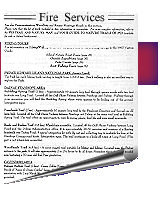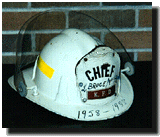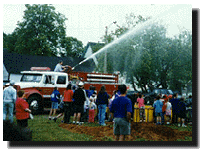
 If Prince Edward Islanders are a unique
people in Canada, the Island’s volunteer
firefighters certainly stand out with their heroic
commitment. Coming from the ranks of business people,
professionals, electricians, teachers, and farmers, they
are all highly dependable folk who are committed to their
community. They never know when the call will
come—during supper, in the middle of the night,
halfway through the big ball game, at work, during their
morning shower, or in the midst of their child’s
birthday party. They are called out for everything from
grass fires to auto accidents. However, all too often,
our firefighters are taken for granted; remembered,
unfortunately, only when their services are needed.
If Prince Edward Islanders are a unique
people in Canada, the Island’s volunteer
firefighters certainly stand out with their heroic
commitment. Coming from the ranks of business people,
professionals, electricians, teachers, and farmers, they
are all highly dependable folk who are committed to their
community. They never know when the call will
come—during supper, in the middle of the night,
halfway through the big ball game, at work, during their
morning shower, or in the midst of their child’s
birthday party. They are called out for everything from
grass fires to auto accidents. However, all too often,
our firefighters are taken for granted; remembered,
unfortunately, only when their services are needed. During the mid-1980s, half of Kensington’s male population wanted to be a member of the Volunteer Fire Department. It was a highly respected organization, active since 1914, whose vital role in the community was undeniable. At that time, Kensington’s department was the most active in the province. To this day, the Kensington Fire Department remains a vital and active part of the local community. The firemen organize dances to raise funds for equipment, put on demonstrations for the community, participate in variety shows and parades, and support local sports. Most importantly, they protect the Town, its residents, and their property, as well as properties in
 surrounding
areas, against destruction by fire. They are truly
admirable citizens. Perhaps one of the most admirable is
former Fire Chief Bruce MacLeod who served on the
Kensington department for 30 years, from 1958 to 1988.
Prince Edward Island has 38 volunteer fire departments
totalling approximately 1,200 volunteers. Charlottetown
has two career firefighters who are paid for their
full-time responsibilities of protecting the
Island’s largest, densely populated city.
surrounding
areas, against destruction by fire. They are truly
admirable citizens. Perhaps one of the most admirable is
former Fire Chief Bruce MacLeod who served on the
Kensington department for 30 years, from 1958 to 1988.
Prince Edward Island has 38 volunteer fire departments
totalling approximately 1,200 volunteers. Charlottetown
has two career firefighters who are paid for their
full-time responsibilities of protecting the
Island’s largest, densely populated city. In Prince Edward Island’s smaller communities and unincorporated areas, however, most volunteer firefighters are trained on the job. Many veteran fighters consider it the hardest but best way to learn. Special training sessions are organized for the volunteers to learn hose work, ladder and rescue work, and general firefighting. Department members must attend such sessions in their free time. These courses are offered at the fire school on Sleepy Hollow Road on the outskirts of Charlottetown, a facility run by the provincial Fire Fighters Association. Approximately 60 percent of Prince Edward Island’s firefighters have Level 2 training, considered the “meat and potatoes” of firefighting. This training covers automobile extraction and rescue from heights whereas Level 1 training covers the basics of how to work safely at a fire scene.
 There was a time when
fighting fires entailed “putting the wet stuff on
the red stuff;” nothing more, nothing less. However,
this was not an easy task in the nineteenth century, when
most public and private buildings on the Island were made
of wood, and water was transported by bucket brigades or
(later) truck-loaded tanks. During this period, fire was
rightly feared. Firefighting has changed significantly
over the past 25 years. Today, fire prevention takes on a
vital importance for fire departments. Many departments
design education and awareness programs to teach their
communities about proper practices to help prevent fires.
Key times of the year include: summer, when people might
be inclined to build campfires or have barbecues; autumn,
when many residents burn excess leaves and lawn waste;
Christmas, when families decorate their homes with
candles and erect Christmas trees; and winter, when
households are building fires in their wood stoves and
fireplaces.
There was a time when
fighting fires entailed “putting the wet stuff on
the red stuff;” nothing more, nothing less. However,
this was not an easy task in the nineteenth century, when
most public and private buildings on the Island were made
of wood, and water was transported by bucket brigades or
(later) truck-loaded tanks. During this period, fire was
rightly feared. Firefighting has changed significantly
over the past 25 years. Today, fire prevention takes on a
vital importance for fire departments. Many departments
design education and awareness programs to teach their
communities about proper practices to help prevent fires.
Key times of the year include: summer, when people might
be inclined to build campfires or have barbecues; autumn,
when many residents burn excess leaves and lawn waste;
Christmas, when families decorate their homes with
candles and erect Christmas trees; and winter, when
households are building fires in their wood stoves and
fireplaces. Police | Education | Health | Waste Management | Government